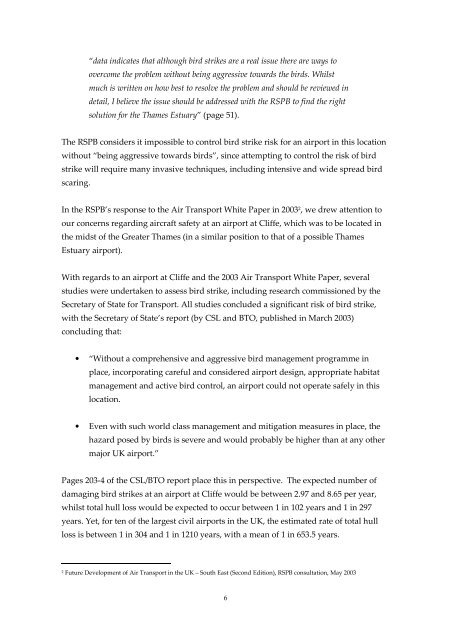1. Ecological objections - London
1. Ecological objections - London
1. Ecological objections - London
Create successful ePaper yourself
Turn your PDF publications into a flip-book with our unique Google optimized e-Paper software.
“data indicates that although bird strikes are a real issue there are ways to<br />
overcome the problem without being aggressive towards the birds. Whilst<br />
much is written on how best to resolve the problem and should be reviewed in<br />
detail, I believe the issue should be addressed with the RSPB to find the right<br />
solution for the Thames Estuary” (page 51).<br />
The RSPB considers it impossible to control bird strike risk for an airport in this location<br />
without “being aggressive towards birds”, since attempting to control the risk of bird<br />
strike will require many invasive techniques, including intensive and wide spread bird<br />
scaring.<br />
In the RSPB’s response to the Air Transport White Paper in 2003 2 , we drew attention to<br />
our concerns regarding aircraft safety at an airport at Cliffe, which was to be located in<br />
the midst of the Greater Thames (in a similar position to that of a possible Thames<br />
Estuary airport).<br />
With regards to an airport at Cliffe and the 2003 Air Transport White Paper, several<br />
studies were undertaken to assess bird strike, including research commissioned by the<br />
Secretary of State for Transport. All studies concluded a significant risk of bird strike,<br />
with the Secretary of State’s report (by CSL and BTO, published in March 2003)<br />
concluding that:<br />
• “Without a comprehensive and aggressive bird management programme in<br />
place, incorporating careful and considered airport design, appropriate habitat<br />
management and active bird control, an airport could not operate safely in this<br />
location.<br />
• Even with such world class management and mitigation measures in place, the<br />
hazard posed by birds is severe and would probably be higher than at any other<br />
major UK airport.”<br />
Pages 203-4 of the CSL/BTO report place this in perspective. The expected number of<br />
damaging bird strikes at an airport at Cliffe would be between 2.97 and 8.65 per year,<br />
whilst total hull loss would be expected to occur between 1 in 102 years and 1 in 297<br />
years. Yet, for ten of the largest civil airports in the UK, the estimated rate of total hull<br />
loss is between 1 in 304 and 1 in 1210 years, with a mean of 1 in 653.5 years.<br />
2 Future Development of Air Transport in the UK – South East (Second Edition), RSPB consultation, May 2003<br />
6
















